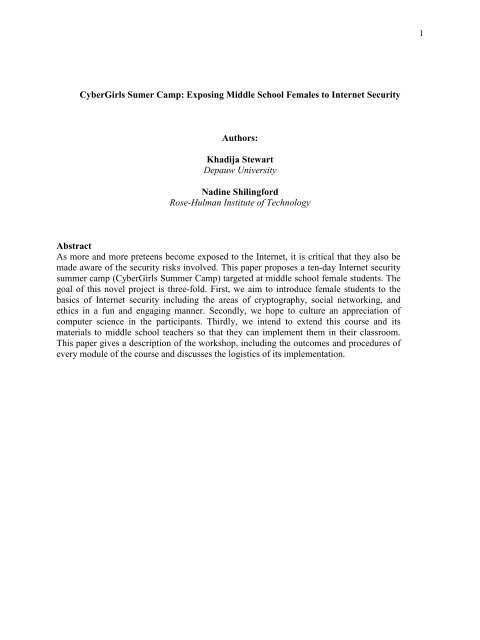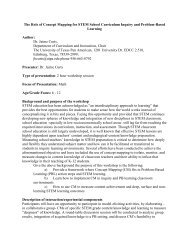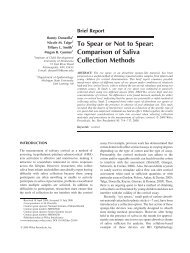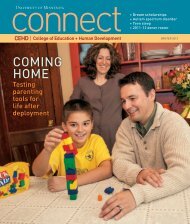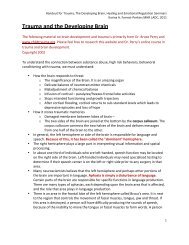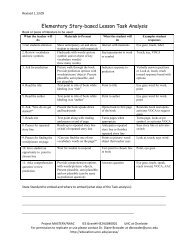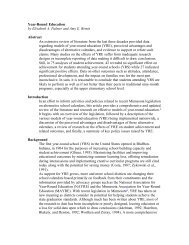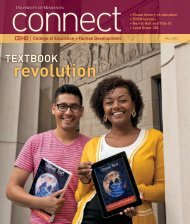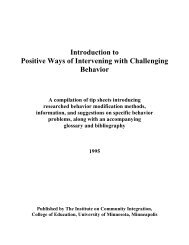CyberGirls Sumer Camp: Exposing Middle School Females to ...
CyberGirls Sumer Camp: Exposing Middle School Females to ...
CyberGirls Sumer Camp: Exposing Middle School Females to ...
Create successful ePaper yourself
Turn your PDF publications into a flip-book with our unique Google optimized e-Paper software.
<strong>CyberGirls</strong> <strong>Sumer</strong> <strong>Camp</strong>: <strong>Exposing</strong> <strong>Middle</strong> <strong>School</strong> <strong>Females</strong> <strong>to</strong> Internet Security<br />
Authors:<br />
Khadija Stewart<br />
Depauw University<br />
Nadine Shilingford<br />
Rose-Hulman Institute of Technology<br />
Abstract<br />
As more and more preteens become exposed <strong>to</strong> the Internet, it is critical that they also be<br />
made aware of the security risks involved. This paper proposes a ten-day Internet security<br />
summer camp (<strong>CyberGirls</strong> Summer <strong>Camp</strong>) targeted at middle school female students. The<br />
goal of this novel project is three-fold. First, we aim <strong>to</strong> introduce female students <strong>to</strong> the<br />
basics of Internet security including the areas of cryp<strong>to</strong>graphy, social networking, and<br />
ethics in a fun and engaging manner. Secondly, we hope <strong>to</strong> culture an appreciation of<br />
computer science in the participants. Thirdly, we intend <strong>to</strong> extend this course and its<br />
materials <strong>to</strong> middle school teachers so that they can implement them in their classroom.<br />
This paper gives a description of the workshop, including the outcomes and procedures of<br />
every module of the course and discusses the logistics of its implementation.<br />
1
1. Introduction<br />
Enrollment of college students in computing fields has su ffered a significant decline since the<br />
internet bubble burst in the early 2000s. According <strong>to</strong> ACT 2010, the number of job openings in<br />
computing are greater than the number of students interested in computing by a fac<strong>to</strong>r of five and<br />
a half. To remedy this, the National Science Foundation ushered several programs <strong>to</strong> help<br />
increase the enrollment of students in computing [9]. Even president Obama has been<br />
encouraging Americans <strong>to</strong> focus on STEM fields. In fact, in his January state address, he stated<br />
that STEM education is necessary <strong>to</strong> “win the future”.<br />
In this work, we propose a ten-day Internet security camp for middle school girls that we<br />
hope will spark their interest in STEM fields, teach them secure internet practices, and increase<br />
their confidence in hard sciences. We chose <strong>to</strong> focus on female students because the percentage<br />
of women in college majoring in STEM fields has been very low and declining for the past<br />
twenty years. According <strong>to</strong> the 2008-2009 Taulbee survey [14], the percentage of women who<br />
received bachelors degrees in Computer Science and Computer Engineering was less than 12%<br />
in the academic year 2007-2008, a steady decline from the 19% that was registered during the<br />
academic year 2000-2001.<br />
Internet and social networking application use, especially among teens has seen a significant<br />
increase in the last few years. Sixty-five percent of teens in the U.S. participate in online<br />
social networking sites such as Facebook [15]. These applications have become so wide spread<br />
that they are now used in personal cellular phones so that teens can have constant access <strong>to</strong> them.<br />
We hope that because of the relevance of this <strong>to</strong>pic <strong>to</strong> the teenager’s social life, we can cultivate<br />
their interest in the workshop. We also believe that teenagers should be taught proper Internet<br />
security practices and be made aware of the ethical issues stemming from Internet security and<br />
social networking. In fact, according <strong>to</strong> [8], 43% of teens reported that they have experienced<br />
some form of Cyberbullying. Furthermore, the NCPC report also states that female teenagers (15<br />
and 16 year olds) are more likely <strong>to</strong> experience Cyberbullying.<br />
Female students tend <strong>to</strong> have less exposure <strong>to</strong> computer science and technology. In fact,<br />
[7] indicates that girls tend <strong>to</strong> lose interest in science in middle school. The authors of this paper<br />
are female Computer Scientists who realize the value of having female role models. Therefore,<br />
the workshop will be conducted by the authors with the help of female computer science<br />
undergraduate students from their respective institutions. An important component of the<br />
workshop is the participation of middle and high school teachers. The authors hope that by<br />
having the school teachers be part of the organization and implementation of the workshop, they<br />
can increase the overall impact of the summer camp. The authors also plan <strong>to</strong> have modules<br />
made available <strong>to</strong> the teachers so that they could incorporate them in their regular curricular.<br />
Despite the national push <strong>to</strong> increase the student’s interest in computing, several states<br />
have not yet incorporated computing in<strong>to</strong> their middle and high school curricular. Indiana, our<br />
state of residence, is unfortunately one of those states [6]. Due <strong>to</strong> the recent nation-wide budget<br />
cuts in the education sec<strong>to</strong>r, we do not expect any additions <strong>to</strong> the curriculum in the near future.<br />
We believe that the creation of easily accessible summer workshops for middle school girls <strong>to</strong> be<br />
a good intermediate solution <strong>to</strong> the problem.<br />
We believe that the novel focus of this workshop will help attract female middle school<br />
students and allow them <strong>to</strong> embrace the workshop experience with an open mind. There are<br />
several workshops offered every year with the aim <strong>to</strong> attract girls <strong>to</strong> science and technology [3,<br />
16, 5] but unlike our proposed solution, none of these workshops are focused on introducing<br />
female middle school students <strong>to</strong> cyber security and the ethics of social networking.<br />
2
We are in the process of writing an NSF proposal <strong>to</strong> secure funding for the summer camp.<br />
Initially, the workshop will take place in central Indiana with plans <strong>to</strong> expand it <strong>to</strong> nearby states<br />
in the near future. We are also designing a Cybersecurity Workshop-in-a-Box <strong>to</strong>olkit that can be<br />
shared with the community so that similar workshops can be implemented in other locations.<br />
Students who successfully complete this workshop should be able <strong>to</strong> (1) explain the<br />
his<strong>to</strong>ry of the Internet and Internet security, discuss major cyber security breaches, Internet trust<br />
system, and preliminary security concepts, (2) describe basic cryp<strong>to</strong>graphy concepts including<br />
key exchange and ciphers, (3) analyze the basic security risks of networks and databases, (4)<br />
identify phishing sites and other security attacks, (5) discuss the ethical issues associated with the<br />
Internet, and (6) develop proper social networking skills. The camp material is divided in<strong>to</strong> four<br />
main modules. We outline the different modules in the course curriculum in Section 2.<br />
Terms<br />
(a) (b)<br />
Figure 1: Examples for Outcome 1 for Module 1.<br />
antivirus, authentication, authorization, backup, cookie cryp<strong>to</strong>graphy cyberbullying,<br />
cybersecurity, denial of service attack, encryption, firewall, hacking identity theft, Internet, IP<br />
address, intrusion, MAC address, network password, permissions, privacy, pro<strong>to</strong>col, virus,<br />
worm, zombie<br />
Table 1: Sample Terms<br />
2. Modules<br />
The following are the modules we plan <strong>to</strong> cover during the workshop. Overall course objectives<br />
are detailed in Section 1. In addition, module objectives are outlined in each of the following<br />
subsections. We propose that the workshop last ten days. During the first seven days of the<br />
workshop, we will cover modules 1 through 4, at the end of module 4, the students will be<br />
divided in<strong>to</strong> groups and asked <strong>to</strong> work on a final project. Each group will be assigned a di fferent<br />
project. The students will work on their final project for two days under our guidance and<br />
guidance of the workshop men<strong>to</strong>rs. The tenth and last day of the workshop will consist of a<br />
poster presentation. Students will be able <strong>to</strong> invite their family members, teachers and friends <strong>to</strong><br />
attend the poster presentation.<br />
2.1 Module 1 -Appreciation for the His<strong>to</strong>ry of Internet and Cyber Security<br />
In this module, students will learn about the his<strong>to</strong>ry of the Internet and cybersecurity. This<br />
3
module lays the groundwork for the subsequent modules. It also aims <strong>to</strong> show the students the<br />
challenges in developing a secure Internet. On completion of this module, the student will be<br />
able <strong>to</strong>:<br />
4
1. Discuss the his<strong>to</strong>ry of the Internet including the circumstances of its creation and<br />
evolution.<br />
2. Define basic terms such as hacking, passwords, Internet, WWW, cybersecurity, cryp<br />
<strong>to</strong>graphy, network, and virus.<br />
3. Understand network pro<strong>to</strong>cols such as HTTP, IP, and SMTP (email).<br />
To achieve Outcome 1, students will be shown a 10-15 minute presentation on the his<strong>to</strong>ry<br />
of the Internet. The students will be given interactive quiz questions after every 2-3 slides <strong>to</strong><br />
review the material presented. Two examples of quiz questions are shown in Figure 1. In<br />
addition, groups of 1-3 students will read excerpts from [12], which detail the his<strong>to</strong>ry of the<br />
Internet starting from Vanevar Bush’s article ”As we may think” [2]. The students will be given<br />
ample time <strong>to</strong> discuss the events occuring in the articles. Once the excerpts have been read and<br />
discussed, the groups will make simple 5 minute presentations <strong>to</strong> the class.<br />
Outcome 2 ensures that students become familiar with some basic Internet security terms.<br />
This is <strong>to</strong> ensure that the students are able <strong>to</strong> communicate with each other in the jargon of<br />
Internet security. Sample terms are listed in Table 1. The students will learn basic terms by<br />
listening <strong>to</strong> short lectures and video clips. The students will participate in a game such as<br />
Vocabulary Jeopardy (similar <strong>to</strong> the popular television game show). Utilizing a game ensures<br />
that a rather mundane task of learning definitions is achieved in a fun activity.<br />
Outcome 3 for this module requires the students <strong>to</strong> understand basic network pro<strong>to</strong>cols<br />
such as HTTP, IP, and SMTP. Short lectures and hands on labora<strong>to</strong>ry exercises will be used <strong>to</strong><br />
introduce networking concepts and pro<strong>to</strong>cols. During the labora<strong>to</strong>ry exercises, we will use a<br />
network sniffer such as Wireshark [18] <strong>to</strong> intercept and analyze network packets.<br />
2.2 Module 2 -Cryp<strong>to</strong>graphy and Ciphers (Why Math is Cool!)<br />
In this module, the students will learn about cryp<strong>to</strong>graphy concepts. The main concepts covered<br />
are:<br />
1. Caesar cipher, mono-alphabetic and poly-alphabetic ciphers.<br />
2. Symmetric key cryp<strong>to</strong>graphy and public key cryp<strong>to</strong>graphy.<br />
3. The core principles of security: confidentiality, integrity, availability, authenticity and<br />
non-repudiation.<br />
This module also includes discussions of real life examples that implement cryp<strong>to</strong>graphy<br />
such as ATM cards, e-commerce sites, and passwords. The morning sessions will consist of very<br />
short lectures (no longer than 5 minutes) interleaved with extended hands on activities. The<br />
activities include solving simple ciphers by hand and using environments such as Alice<br />
[1] and Scratch [13]. To learn about cryp<strong>to</strong>graphy and passwords, resources such as [10] will be<br />
used. The afternoon sessions will consist of labora<strong>to</strong>ry exercises that the students work on in<br />
groups.<br />
The goal of the labora<strong>to</strong>ry sessions is <strong>to</strong> re-enforce the concepts learned in the morning<br />
sessions, practice the concepts using simulated and real-world environments and situations and<br />
enforce group work and student involvement. After each labora<strong>to</strong>ry session, the students will<br />
have a tangible outcome that they create or help create (whether that is a simulated world, a list<br />
of scenarios, etc). The labora<strong>to</strong>ries for this module are described below:<br />
5
Labora<strong>to</strong>ry exercise 1—Ceasar, Mono-aplhabetic and poly-alphabetic ciphers: During<br />
this labora<strong>to</strong>ry exercise, the students will use the Alice environment <strong>to</strong> practice using the Ceasar,<br />
Mono -alphabetic and poly-alphabetic ciphers. We developed an Alice project that depicts a<br />
scenario where two individuals need <strong>to</strong> communicate in a secure manner. We also implemented<br />
two methods for each cipher, encode and decode. The method encode takes the plaintext and<br />
produces the corresponding cipher-text and the method decode reverses the process. The students<br />
will get a chance <strong>to</strong> experiment with both methods using different plain-texts and keys and report<br />
on the differences between the three ciphers. The students will also have the chance <strong>to</strong> build on<br />
the Alice simulated world by adding new characters and cus<strong>to</strong>mizing the scenarios.<br />
Labora<strong>to</strong>ry exercise 2—Symmetric and public key cryp<strong>to</strong>graphy: In this labora<strong>to</strong>ry<br />
exercise, we will use the HTTPS pro<strong>to</strong>col as the case study. This will give us the opportunity <strong>to</strong><br />
explain the purpose of HTTP and the his<strong>to</strong>ry of the World Wide Web (interactive learning<br />
techniques such as the ones detailed in module 1 will be used in this portion of the lab). We will<br />
use the Wireshark [18] network sniffer <strong>to</strong> capture and analyze all the HTTPS messages<br />
exchanged between a local host and a server. The students will then be given detailed<br />
instructions that will help them analyze the data captured by Wireshark and write a report.<br />
Labora<strong>to</strong>ry exercise 3—Security principles: This labora<strong>to</strong>ry session will consist of two<br />
portions. In the first portion of the labora<strong>to</strong>ry session, the students will be divided in<strong>to</strong> groups of<br />
two or three and given several scenarios where characters need <strong>to</strong> communicate securely. The<br />
groups will then be asked <strong>to</strong> identify the security principals required for each scenario. In the<br />
second portion of the labora<strong>to</strong>ry session, the students will be asked <strong>to</strong> work in groups of two or<br />
three and develop their own scenarios and identify the principles required for each of their<br />
scenarios. The groups will then share their scenarios with the rest of the class.<br />
2.3 Module 3 -Oh No! I’ve Been Hacked!<br />
The goal of this module is <strong>to</strong> educate students on safe Internet practices. To achieve this, we will<br />
cover the main cyber security attacks. The most popular cyber attacks covered in this module<br />
are:<br />
1. SQL injection attacks.<br />
2. Cross site scripting attacks.<br />
3. Phishing attacks.<br />
In this module, we will cover the his<strong>to</strong>ry and ethics of hacking the Internet and discuss ethical<br />
issues related <strong>to</strong> cyber security. The morning sessions will consist of very short lectures (less<br />
than 5 minutes long) explaining each attack followed by hands on activities. The activities will<br />
include using interactive learning games and videos such as Anti-Phishing Phil [11]. The<br />
students will also read short articles about cyber attacks and debate issues related <strong>to</strong> the ethics of<br />
hacking. The afternoon sessions will consist of the following labora<strong>to</strong>ries:<br />
Labora<strong>to</strong>ry exercise 1—SQL injection attacks: This labora<strong>to</strong>ry exercise consists of two parts. In<br />
part 1, the students will learn SQL and practice using it in an emula<strong>to</strong>r that will allow them <strong>to</strong><br />
create and manipulate tables and records. The second part of the session consists of a hacking<br />
exercise where the students will work in groups and use a few SQL queries <strong>to</strong> hack in<strong>to</strong> a site<br />
that we have created for this exercise.<br />
6
Labora<strong>to</strong>ry exercise 2—Cross site scripting attacks: In this labora<strong>to</strong>ry exercise, we will show<br />
the students videos of XSS attacks and guide them through an exercise using a virtual machine.<br />
This will give us a chance <strong>to</strong> talk about the use of virtual machines and their application <strong>to</strong> cyber<br />
security. The students will complete an XSS exercise using the WebGoat [17] application.<br />
Labora<strong>to</strong>ry exercise 3—Phishing attacks: This labora<strong>to</strong>ry session will consist of two parts. In<br />
the first part of the session, the students will use the Anti-Phishing Phil interactive <strong>to</strong>ol, this <strong>to</strong>ol<br />
will enable the students <strong>to</strong> recognize phishing websites and help them learn <strong>to</strong> always keep good<br />
security practices in mind when using the internet. In the second part of the labora<strong>to</strong>ry session,<br />
the students will work in groups on designing a phishing email. The purpose of this exercise is <strong>to</strong><br />
train the students <strong>to</strong> pay attention <strong>to</strong> small details. The groups will then exchange their emails<br />
and comment on each other’s work.<br />
2.4 Module 4 -What Not To Do on Facebook<br />
This module will include an introduction <strong>to</strong> social networking and its social, economical, and<br />
ethical implications. On completion of this module, the students will be able <strong>to</strong>:<br />
1. Explain the concept of social networking.<br />
2. Identify positive aspects of social networking.<br />
3. Identify un-ethical actions on social networking sites.<br />
Outcomes 1 and 2 will be achieved using short introduc<strong>to</strong>ry presentations on social networking.<br />
Outcome 3 will be achieved using a sequence of videos, readings and discussions. The students<br />
will be given case studies and they will evaluate whether the actions in the case studies were<br />
appropriate, safe, un-ethical or illegal. A sample case study is as follows:<br />
Tina’s family is going on a vacation and she is very excited. She posts the following<br />
comment on her Facebook status: ”We’re going on vacation!!!! We’re leaving on<br />
Monday at 3:30pm and coming back on Saturday at 5:15pm. Hope my plant in my<br />
bedroom doesn’t die while we’re gone!!! LOL!!!”<br />
In addition, the students will choose articles on social networking and bring them <strong>to</strong> class<br />
for discussion and analysis.<br />
3. Workshop Logistics<br />
This Section gives the logistical details of the workshop including the workshop schedule, staff<br />
and equipment.<br />
Module Topic Days<br />
3.1 Tentative<br />
1 His<strong>to</strong>ry of Internet and Security The<br />
Schedule<br />
1 2<br />
World Wide Web and HTTP<br />
Table 2: Time 2 Cryp<strong>to</strong>graphy Field Trip Using a 3 3 4<br />
outline<br />
of modules and Programming Environment<br />
<strong>to</strong>pics<br />
3 Cyber Attacks Ethics of Cyber<br />
Security<br />
5 6<br />
4 Social Networking 7-8<br />
Project Work on Final Project 8-9<br />
Presentations Poster presentations 10<br />
7
Table 2 gives a preliminary outline for the activities that the students will be involved in every<br />
day of the workshop. The students will be in class for a <strong>to</strong>tal of four hours every day (two hours<br />
in the morning and two hours in the afternoon). The rest of the time will be spent doing activities<br />
designed by the authors and the workshop men<strong>to</strong>rs. These activities would include friendly<br />
soccer, volleyball or basketball games, board games, group discussions, invited speakers,<br />
treasure hunts, visiting a nature park, picnics, cookouts etc...<br />
3.2 <strong>Middle</strong> <strong>School</strong> Teacher Participation<br />
One of the goals of <strong>CyberGirls</strong> is <strong>to</strong> attempt <strong>to</strong> integrate computer science concepts in the middle<br />
school curriculum in Indiana. To achieve this, middle school teachers will be invited <strong>to</strong> attend<br />
the camp. We will train the teachers on the workshop modules and ask them <strong>to</strong> help men<strong>to</strong>r the<br />
students during the workshop. We believe that this is a good idea because teachers can not only<br />
learn the new material but also observe the student’s appreciation for the material. At the end of<br />
the session, we will supply materials <strong>to</strong> the teachers so that they can introduce them <strong>to</strong> their<br />
classrooms. The middle school teachers will be given a stipend for their participation and help<br />
with the workshop.<br />
3.3 Staff<br />
The authors will be the main direc<strong>to</strong>rs of the <strong>CyberGirls</strong> workshop. We will be supported by<br />
student counselors from our individual institutions and by the middle school teachers. The<br />
student counselors will be paid a stipend for their participation. The student counselors will help<br />
students with the labora<strong>to</strong>ry exercises and the projects, they will accompany the students on field<br />
trips, and manage the <strong>CyberGirls</strong> website.<br />
3.4 Equipment and Cost/Funding<br />
We envision that we will need computers for the labora<strong>to</strong>ry exercises and projects as well as<br />
other miscellaneous supplies (poster boards, incentives and gifts, student binders and prin<strong>to</strong>uts,<br />
and so on). However, we have not calculated the <strong>to</strong>tal cost of the summer camp as yet. We are<br />
currently in the process of researching costs and are drafting an NSF proposal. Both our<br />
institutions have a long his<strong>to</strong>ry of conducting camps for middle and high school students, we<br />
envision <strong>to</strong> have the camps in our institutions and use our institutions’ labora<strong>to</strong>ry equipment.<br />
3.5 Recruitment and Followup<br />
We will actively recruit for the camp by visiting local middle schools and talking <strong>to</strong> the school<br />
officials about the camp. We also plan on conducting a few outreach sessions at the schools <strong>to</strong><br />
promote the camp. The students will have <strong>to</strong> pay a small nominal fee <strong>to</strong> reserve their seat at the<br />
camp in order <strong>to</strong> guarantee their participation. The camp cost will be covered by the grant, the<br />
fee will only be used <strong>to</strong> ensure the student’s participation.<br />
4. Conclusion<br />
This paper presents a new type of workshop with the goal <strong>to</strong> attract female students <strong>to</strong><br />
computing, increase their con fidence in hard sciences and entice middle -school teachers <strong>to</strong><br />
incorporate some of the workshop concepts in<strong>to</strong> their curriculum.<br />
8
References<br />
[1] Alice, www.alice.org<br />
[2] Vannevar Bush, As We May Think. Atlantic Magazine, July 1945.<br />
[3] CS4HS, http://www.cs.cmu.edu/cs4hs/summer10/workshops.html<br />
[4] Indiana K-12 school funding cuts <strong>to</strong> hit in January 2010, http://www.indianaeconomicdigest.<br />
net/main.asp?SectionID=31&subsectionID=240&articleID=51737<br />
[5] Dennis P. Groth, Helen H. Hu, Betty Lauer, and Hwajung Lee. 2008. Improving computer<br />
science diversity through summer camps. SIGCSE Bulletin 40, 1 (March 2008), 180-181.<br />
[6] <strong>Middle</strong> <strong>School</strong> Business and Information Technology, http://dc.doe.in.gov/Standards/<br />
[7] L. A. Milbourne. Encouraging girls in science math. The Eric Review k-8 Science and<br />
Mathematics Education, 6(2):4547, Fall 1999.<br />
[8] National Crime Prevention Council, Teens and Cyberbullying, Executive Summary Of A<br />
Report On Research. February 28, 2007.<br />
[9] NSF programs http://www.nsf.gov/funding/pgm_summ.jsp?pims_id=5488/<br />
[10] Passwords: ”Long, Strong, but Memorable”, http://tri<strong>to</strong>n.<strong>to</strong>wson.edu/ ~ cssecinj/secinj/<br />
?page_id=1669<br />
[11] Anti-Phishing Phil, http://www.wombatsecurity.com/<br />
[12] Sally Richards, Futurenet: The Past, Present, and Future of the Internet as Told by Its<br />
Crea<strong>to</strong>rs and Visionaries. John Wiley & Sons, Inc, 2002.<br />
[13] Scratch, http://scratch.mit.edu/<br />
[14] Taulbee reports, http://www.cra.org/uploads/documents/resources/taulbee/0809.pdf<br />
[15]Teens and social media, http://www.pewinternet.org/Reports/2007/<br />
Teens-and-Social-Media.aspx<br />
[16] UTCS outreach, http://outreach.cs.utexas.edu/firstbytes/<br />
[17] Webgoat, https://www.owasp.org/index.php/Category:OWASP_WebGoat_Project<br />
[18] Wireshark, http://www.wireshark.org<br />
9


